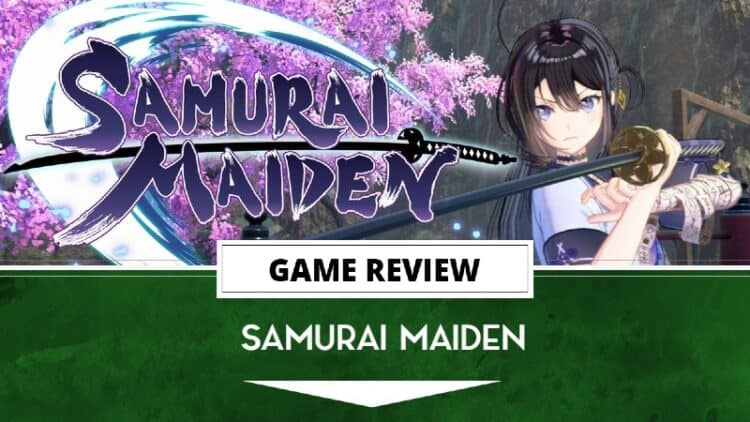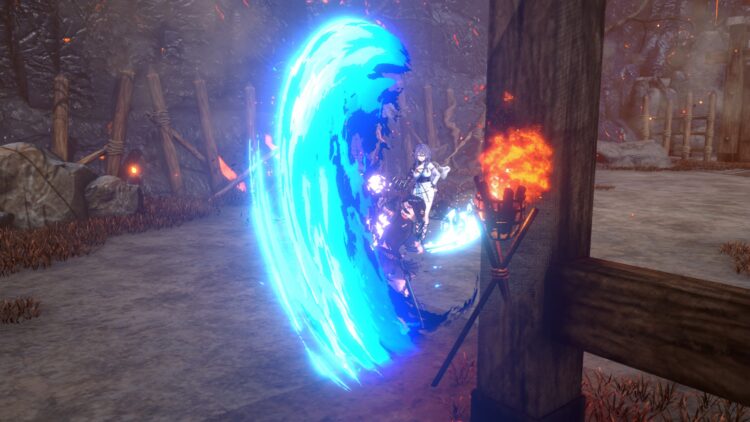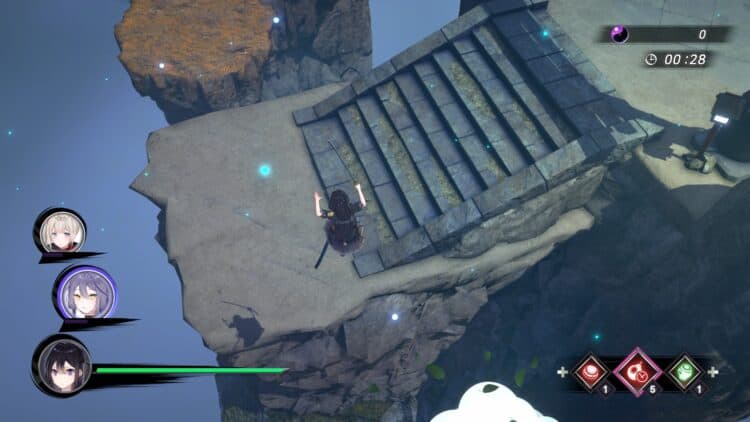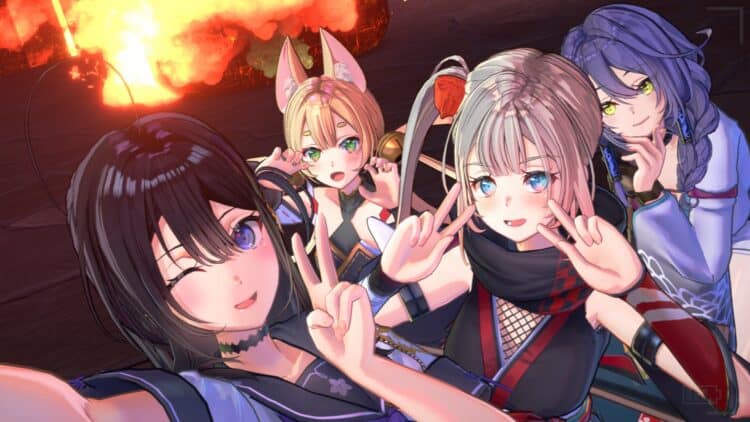As soon as the first trailer from D3publisher showed off Samurai Maiden, I had a variety of people I know, send it to me, knowing the kinds of games I play. As soon as I saw the trailer, we get a glimpse of a girl from the current era taking a samurai katana from the past and killing demons and skeletons in the underworld. That trailer made me follow all the Youtube channels to see the new characters and visuals, and I am very glad I did. Each new character shown was a blast. How did this game live up to my expectations of it?
Game Name: Samurai Maiden
Platform(s): PlayStation 4, Nintendo Switch, PC (Reviewed)
Publisher(s): D3publisher
Developer(s): Shade Inc
Release Date: December 8th, 2022
Price: $59.99
Samurai Maiden gave me a mixed bag of emotions the more I played the game. The visuals were impressive, but only a few cinematics in this type of art style should be a crime. The hack-and-slash mechanics were much more in-depth than I was expecting, which was a nice surprise. You play Tsumugi, a girl in the current era still in school who gets transported to the fantasy Sengoku period of Japan as she meets Nobunaga Oda in Honnō-Ji during the fire started by Mitsuhide Akechi as he plans to murder Nobunaga. Tsumugi learns she is of the bloodline of the Priestess of Harmony, making her a Priestess of Harmony who is foretold to kill the Demon Lord beneath the temple of Honnō-Ji.

The Trail to the Demon Lord
Samurai Maiden has a small introduction before it throws you out to the wolves to fight a bunch of undead with a sword given to you by Iyo, a ninja under Nobunaga. The first fight is rough as they teach you the basics. Mainly for one reason, you have no combos at the start. You can do light attacks, heavy attacks, and a roll. The more you build your relationships in the game, the more combos and moves you will gain access to. I appreciate giving this incentive to focus on your relationship with these characters. The way you build that relationship is by using their abilities and fighting skeletons with them. Throughout the game, you get glimpses of Tsumugi’s life in the current time as she is building her relationship with Iyo, Hagane, and Komimi.
At first, I was a bit put off by the opening giving us so little detail of the characters, but the more I think about it, the more it makes sense. This game is an isekai obviously, so they wanted to make you feel like you also have been isekaied. You have to learn the controls fast enough to take down some of these tougher enemies. Building your relationship with Iyo gives you moves that help your light attack combos, Hagane gives you heavy attack additions to your move set, and Komimi gives you more utility on the battlefield.
There is a degree of platforming in this game as you jump and roll your way over to the next big arena area that houses a giant undead skeleton. Once you reach that skeleton, they summon a small number of skeletons that continue to respawn as you are fighting the big bad. Pretty much every level is this same setup. You start on a path that has a small number of branching paths with one main one that goes through a variety of arena areas housing bigger enemies that summon small enemies. The smaller branching paths have collectible memory fragments that have a good chunk of the concept art of the game. I honestly love seeing concept art as unlockable in games, it feels like that doesn’t happen nearly as much as it used to.
There are also times when a level is just a single boss encounter. These usually have one powerful enemy that isn’t a skeleton, and the fighting is much more methodical. You can’t just outpower the enemy. You have to wait for them to wind down in their attacks to give them a few combos before going back to the defensive again. Some bosses were much more difficult than others in this sense. Beating them, however, gives you a great sense of satisfaction.
As you are building up relationships with your allies, you will get access to bubble pockets with them individually. These bubble pockets usually require you to use their special abilities to get through the level as well as a giant fight with a skeleton. After you finish a bubble pocket, you get something that will help your ally be more useful. That could be a new weapon or another gauge to their Ninja bar.
When you start to understand the combos and use your ninja’s abilities with their specific shortcut in the menu, you can deal a massive amount of damage. When I was in the zone fighting two giant skeletons and their small masses of armies, I felt like a sword master stunning and juggling enemies off the wazoo. The problem arises when enemies get harder and harder due to becoming more spongelike. You can mitigate it by using the Inga you acquire to increase your base stats or your ninja party members’ stats. After spending the first bouts of Inga on my outfits for Iyo and Tsugumi, I felt forced to constantly use the rest of it on myself for HP and Attack power. You get Inga in every stage based on how many enemies you killed. Small and large enemies alike give you Inga. Inga is used to increase your stats or unlock things. As you get farther in the game, you also acquire more weapons for Tsugumi to use. This is a problem as those weapons don’t scale with the progression, so you’ll have to level those up as, and it’s quite a nunsense. Because I this, I found myself using the first Katana I found thoughout the entire game due to not wanting to waste Inga on leveling up the other weapons.
Traversing the Underworld
Combat in Samurai Maiden is solid, but there is still one aspect I need to go over, platforming. Between arena areas, there are sometimes jumps, things to climb, or puzzles to solve. These are the weakest parts of the game, and sadly it gets hurt by one of the save mechanics. If you find a shrine in the level, it saves your progress in that level up to that point for the current run you are in. Usually, the shrines are before the next arena starts. If you die before you can make it to the shrine, the game will make you restart the level from the beginning.
So if you beat an arena fight and are making your way to the shrine and die by falling off several times or by an obstacle, you will have to do the first arena fight all over again. This doesn’t help further that the jumping is pretty hard to gauge. I often found myself having to force the camera down to see if my shadow could make a jump. This frustrated me, especially in some areas where if you jump, it wants you to jump almost instantly afterward. I would put the camera down to gauge my jump, then move the camera back up to find where I needed to go next, then pan down a second down to make sure I could make the jump. When it was platforms that would buckle under the weight of Tsugumi, I would usually die before the next jump and have to redo everything all over again. I would have probably finished this game sooner if I wouldn’t rage quit on a level because I didn’t want to fight the first few arenas getting to a platforming section again.
If you got to a shrine in Samurai Maiden before a big battle and died once, it would take you to the shrine. If you died a second time in the big battle, it would take you back to the beginning of the level again. I don’t know if this was intentional or not, yet it made me not want to redo levels until I was ready to go back to the stage. Most stages are pretty short, but sometimes the stages can be long. A short stage can take from four to five minutes. A long stage can take from 10 to 20 minutes. Normally this isn’t that bad, but if it means having to redo a long platforming puzzle again or a gauntlet of arenas, it can be quite taxing on my motivation.
While my time with the game was with the PC, I did give it a try on the Steam Deck, but sadly it didn’t work. The short levels, though, would have been perfect on it. Every time I would boot up the game on Steam Deck, it would get stuck on the title screen, and I couldn’t get past it. Even with using a keyboard or mouse. I hope this does get rectified so I can get small bursts of playtime in to get more Inga and unlock more outfits and levels for my other weapons. On my pc with an NVIDIA RTX 3060 graphics card, this game ran smoothly aside from one level. Level 23 makes you fight four giant skeletons and the small masses of skeletons that get made from each big one. This dipped the frame rate by a noticeable chunk. It was one of the reasons I died so much in Level 23 was that I thought I would have dodged, but the frames were dropped during the roll, so I couldn’t roll a second time fast enough and would get hit by them easily.
Sengoku Era
Overall, Samurai Maiden is an enjoyable time with some issues with the platforming and saving systems within the levels. If it was just the combat, I probably would have had a better time with the game. I will most likely return to the game to level up some of the other weapons a bit more and get better with some of the combos. Though I will say I did mainly just go to the levels that have combat only without too many platforming sections, so I don’t get frustrated from over or under-jumping due to being unable to gauge the distance. Plus, after beating the game, you’ll unlock other difficulty modes.
Samurai Maiden is available on PlayStation 4, PlayStation 5, Nintendo Switch, and PC.
Review Disclosure Statement: Samurai Maiden was provided to us by D3publisher for review purposes. For more information on how we review video games and other media/technology, please review our Review Guideline/Scoring Policy for more info.
Affiliate Link Disclosure: One or more of the links above contain affiliate links, which means at no additional cost to you, we may receive a commission should you click through and purchase the item.
Summary
Samurai Maiden is an enjoyable action Hack and slash game that has great visuals. The combat in the game is solid, but not all the mechanics are quite as polished as its combat. An enjoyable story that picks up quite a bit in the second half of the game. These characters are great and I do want to see more of them in the future!
Pros
- Great combat
- Visuals are stunning
- Characters are enjoyable
Cons
- Platforming could be better
- Save system works awkwardly





